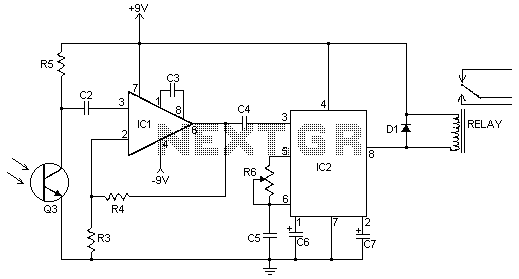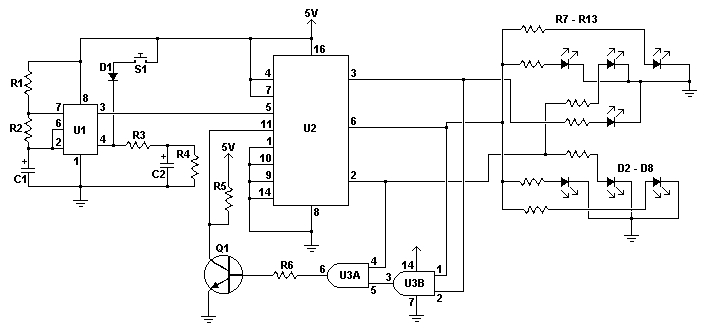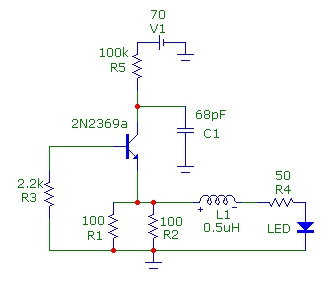
ir remote circuit

A series of emails have been received requesting schematics for infrared remotes. This document presents a schematic for such a remote, which transmits a tone using an infrared LED. The tone is decoded by the receiver, ensuring that the receiver activates only when it detects the tone, thereby preventing accidental activations.
The infrared remote control circuit operates by using an infrared LED to emit a modulated signal, which is typically a square wave tone. The modulation frequency can vary, but common frequencies are in the range of 30 kHz to 40 kHz. This modulation allows the receiver to differentiate between the remote control signal and other ambient infrared signals, such as sunlight or incandescent lighting.
The schematic for the infrared remote control consists of several key components:
1. **Infrared LED**: This component emits the infrared light signal when activated. It is driven by a transistor or a microcontroller output pin, which modulates the LED based on the desired tone.
2. **Modulation Circuit**: A simple oscillator circuit can be used to generate the modulation frequency that drives the infrared LED. This can be implemented using a 555 timer IC configured in astable mode or a microcontroller programmed to output a PWM signal.
3. **Power Supply**: The remote control circuit typically requires a low-voltage power supply, often provided by batteries. A voltage regulator may be included to ensure stable operation.
4. **Control Buttons**: The remote will include push buttons that, when pressed, send specific commands. These buttons are connected to the modulation circuit to trigger the appropriate tone corresponding to each command.
5. **Receiver Circuit**: The receiving end consists of an infrared photodiode or phototransistor that detects the incoming infrared signal. This component is often paired with a bandpass filter to isolate the modulation frequency, enhancing the receiver's ability to recognize the intended signal.
6. **Decoding Circuit**: Once the signal is detected, it is processed by a microcontroller or other logic circuitry that decodes the tone. Based on the decoded signal, the receiver can then control other devices, such as turning on a light or activating a motor.
7. **Output Control**: The decoded signals can be used to drive relays or transistors to control higher power devices, ensuring that the remote can operate a variety of electronic appliances.
This design allows for a reliable and user-friendly interface, where the user can control devices without the risk of accidental activation, as the receiver will only respond to the specific tone generated by the remote. The simplicity of the circuit design also makes it suitable for various applications, from home automation to remote-controlled toys.I have received a number of emails requesting schematics for infa-red remotes. So here is one. This remote transmits a tone using an infa-red LED. This tone is decoded by the receiver. Since the receiver only switches when it "hears" the tone, there are no accidental activations. 🔗 External reference
The infrared remote control circuit operates by using an infrared LED to emit a modulated signal, which is typically a square wave tone. The modulation frequency can vary, but common frequencies are in the range of 30 kHz to 40 kHz. This modulation allows the receiver to differentiate between the remote control signal and other ambient infrared signals, such as sunlight or incandescent lighting.
The schematic for the infrared remote control consists of several key components:
1. **Infrared LED**: This component emits the infrared light signal when activated. It is driven by a transistor or a microcontroller output pin, which modulates the LED based on the desired tone.
2. **Modulation Circuit**: A simple oscillator circuit can be used to generate the modulation frequency that drives the infrared LED. This can be implemented using a 555 timer IC configured in astable mode or a microcontroller programmed to output a PWM signal.
3. **Power Supply**: The remote control circuit typically requires a low-voltage power supply, often provided by batteries. A voltage regulator may be included to ensure stable operation.
4. **Control Buttons**: The remote will include push buttons that, when pressed, send specific commands. These buttons are connected to the modulation circuit to trigger the appropriate tone corresponding to each command.
5. **Receiver Circuit**: The receiving end consists of an infrared photodiode or phototransistor that detects the incoming infrared signal. This component is often paired with a bandpass filter to isolate the modulation frequency, enhancing the receiver's ability to recognize the intended signal.
6. **Decoding Circuit**: Once the signal is detected, it is processed by a microcontroller or other logic circuitry that decodes the tone. Based on the decoded signal, the receiver can then control other devices, such as turning on a light or activating a motor.
7. **Output Control**: The decoded signals can be used to drive relays or transistors to control higher power devices, ensuring that the remote can operate a variety of electronic appliances.
This design allows for a reliable and user-friendly interface, where the user can control devices without the risk of accidental activation, as the receiver will only respond to the specific tone generated by the remote. The simplicity of the circuit design also makes it suitable for various applications, from home automation to remote-controlled toys.I have received a number of emails requesting schematics for infa-red remotes. So here is one. This remote transmits a tone using an infa-red LED. This tone is decoded by the receiver. Since the receiver only switches when it "hears" the tone, there are no accidental activations. 🔗 External reference





